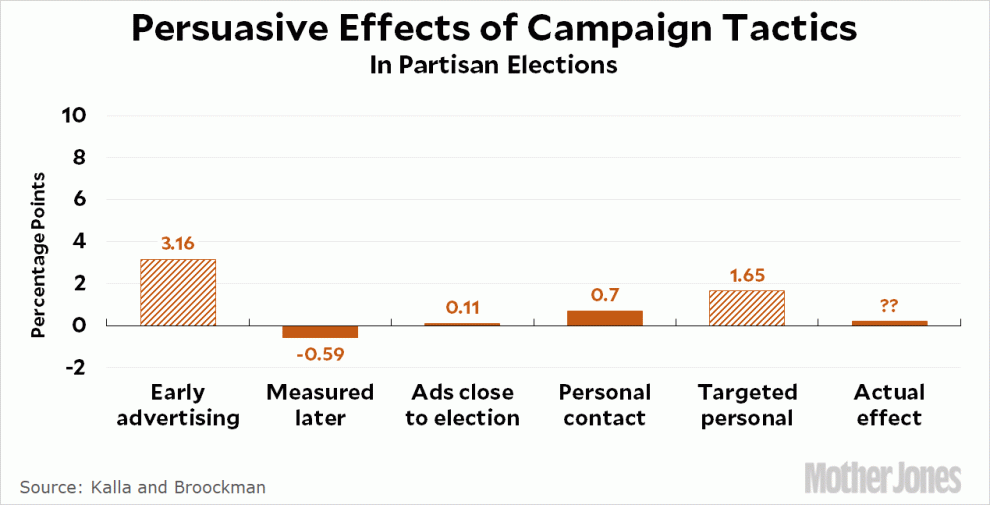
It’s taken me a while to get to this, but it’s probably of considerable interest to us political junkie types. Joshua Kalla and David Broockman, who have been involved for some time in research on campaign tactics, recently undertook some very powerful field experiments to get a better fix on what works and what doesn’t when it comes to persuading voters. They reported their findings in a recent paper, and the bottom line is grim: party cues are now so powerful that nothing works in partisan general elections. Here are the basic findings, which I’ll explain below:

The first bar shows the effects of advertising a few months before an election. It looks promising! But as the second bar shows, it wears off by Election Day. In fact, the impact might even backfire, producing fewer votes than doing nothing at all.
So how about just running the ads within two months of the election? Sorry. The effect is minuscule.
How about door-to-door canvassing, the gold standard of campaigning? Previous field experiments had suggested it actually has a negative effect, but the new, more powerful studies were slightly more positive: the effects aren’t negative, but they’re pretty close to zero.
Finally, there’s something that Kalla and Broockman call “targeted” persuasion. This involves detailed surveys to identify voters who might be persuadable on a particular issue (abortion, say) and then hitting them with ads or phone calls on just that subject. At first glance this seems promising, with an average effect of about 1.65 percentage points.
But that’s 1.65 percentage points among a very small group. As a percentage of the entire electorate, it’s much smaller. And it’s very expensive to do this kind of thing.
In other words, nothing works:
The best estimate for the persuasive effects of campaign contact and advertising—such as mail, phone calls, and canvassing—on Americans’ candidate choices in general elections is zero. Our best guess for online and television advertising is also zero, but there is less evidence on these modes.
The paper is not entirely bad news. Ordinary campaigning works fairly well in primary elections, where both candidates are from the same party, and for ballot measures. The authors also emphasize that although few people are genuinely persuadable, there are other tools that do work: registration drives among likely supporters and ground-game efforts to get your supporters to the polls (GOTV).
But if you’re hoping to change people’s minds in a partisan race, good luck. You probably won’t. This is why American elections have become such dismal slogs of attack ads and appeals to the base. Nothing else really seems to have much effect.








